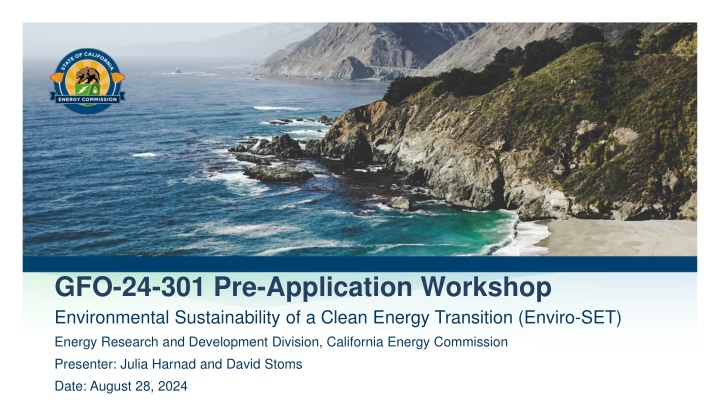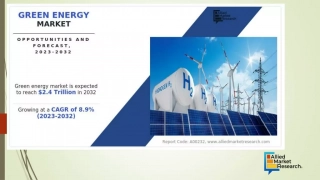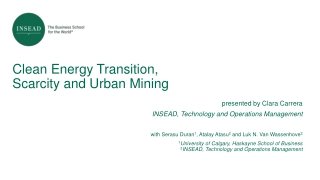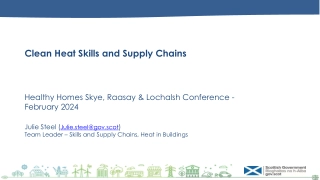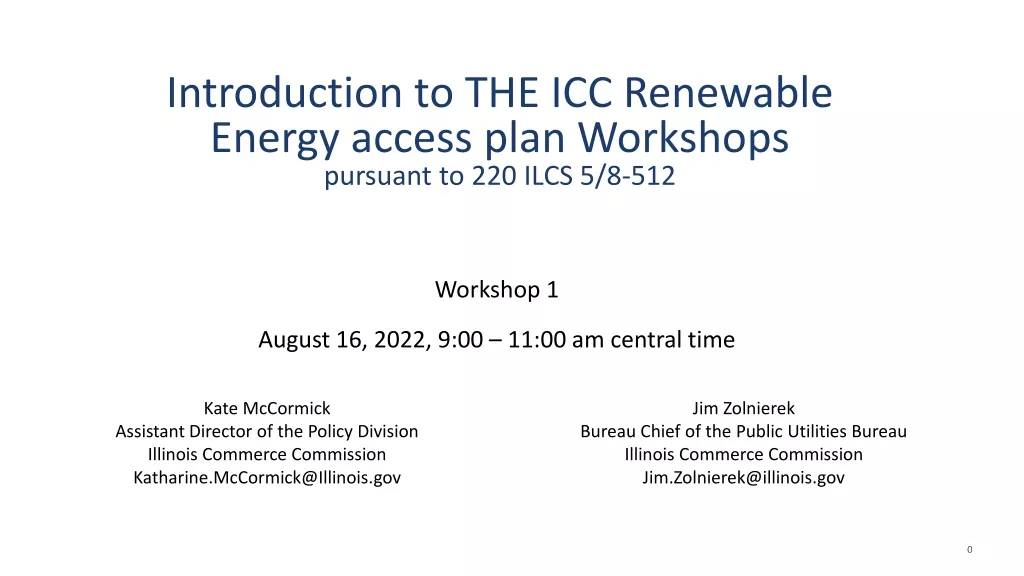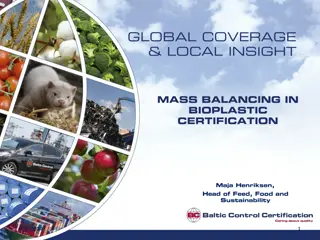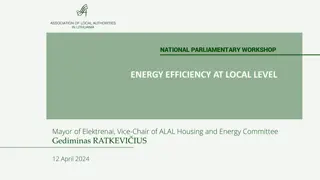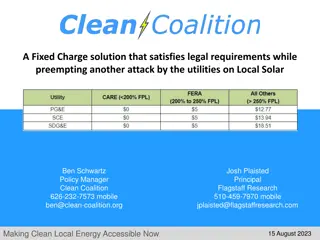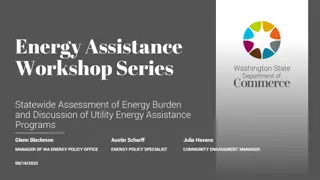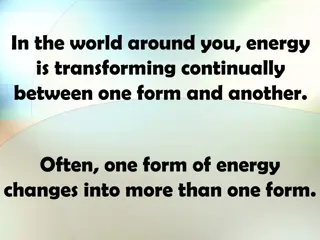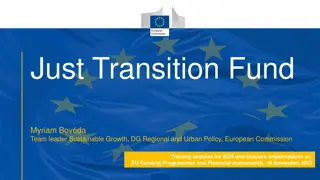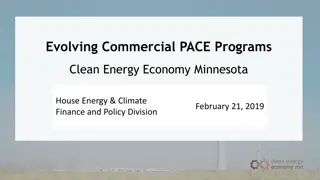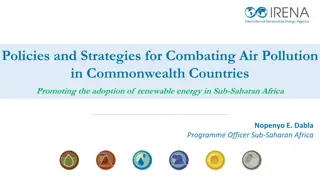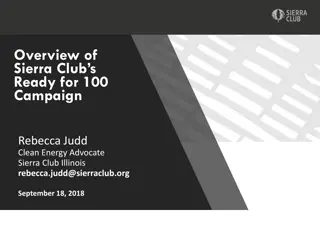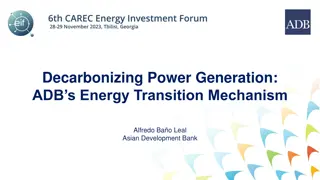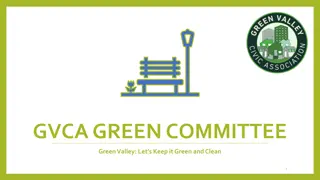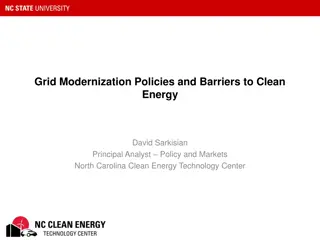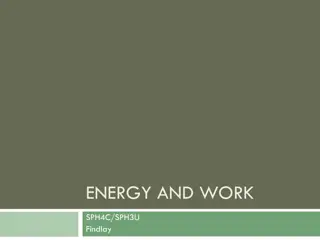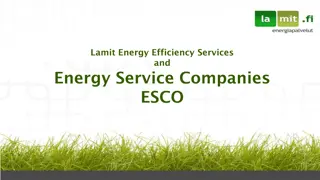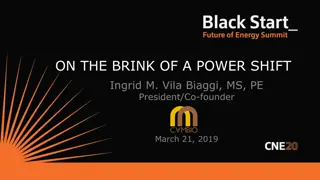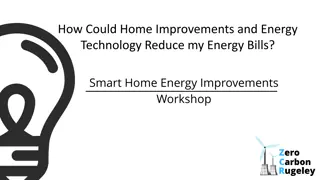Sustainability Workshop: Clean Energy Transition & Diversity Commitment
This workshop hosted by the California Energy Commission focuses on environmental sustainability in the clean energy transition, featuring discussions on funding opportunities, application requirements, and diversity commitments. Attendees can engage through Q&A sessions and participation surveys. Stay updated on the CEC website for more information and connect with relevant resources. Join us to be part of the clean energy movement!
Download Presentation

Please find below an Image/Link to download the presentation.
The content on the website is provided AS IS for your information and personal use only. It may not be sold, licensed, or shared on other websites without obtaining consent from the author.If you encounter any issues during the download, it is possible that the publisher has removed the file from their server.
You are allowed to download the files provided on this website for personal or commercial use, subject to the condition that they are used lawfully. All files are the property of their respective owners.
The content on the website is provided AS IS for your information and personal use only. It may not be sold, licensed, or shared on other websites without obtaining consent from the author.
E N D
Presentation Transcript
GFO-24-301 Pre-Application Workshop Environmental Sustainability of a Clean Energy Transition (Enviro-SET) Energy Research and Development Division, California Energy Commission Presenter: Julia Harnad and David Stoms Date: August 28, 2024
Agenda Time Item 10:00 am Welcome and Introduction 10:05 am Solicitation Background EPIC Research Program Purpose of Solicitation Available Funding Application Requirements Project Group Requirements Attachments Submission Process Evaluation Process 10:25 am 11:00 am Q&As 12:00 pm Adjourn 2
Workshop Information This workshop will be recorded and posted to the CEC website here: https://www.energy.ca.gov/event/funding- workshop/2024-08/pre-application-workshop-gfo-24-301- environmental-sustainability Attendees will be muted during the presentation. Please chat your question using the Q&A window. Updates to solicitation documents will be posted at the Grant Funding Opportunity s webpage: https://www.energy.ca.gov/solicitations/2024-08/gfo-24-301- environmental-sustainability-clean-energy-transitions-enviro- set 3
Commitment to Diversity The Energy Commission adopted a resolution strengthening its commitment to diversity in our funding programs. The Energy Commission continues to encourage disadvantaged and underrepresented businesses and communities to engage in and benefit from our many programs. To meet this commitment, Energy Commission staff conducts outreach efforts and activities to: Engage with disadvantaged and underrepresented groups throughout the state. Notify potential new applicants about the Energy Commission s funding opportunities. Assist applicants in understanding how to apply for funding from the Energy Commission s programs. Survey participants to measure progress in diversity outreach efforts. 4
We Want to Hear From You! Participation Survey Survey responses will be summarized anonymously to track attendance of underrepresented groups in our workshops for public reporting purposes. Online participants, please use this link: https://forms.office.com/pages/responsepag e.aspx?id=RBI6rPQT9k6NG7qicUgZTmZQ QhVkOulBuu_RhfhezOlUNEswN0RTMUZH N04xNVdNUVBUUVBRRkE1Ty4u&route=s horturl Thanks! 5
Find a Partner on EmpowerInnovation.net Empower Innovation strives to accelerate your clean tech journey with easy access to funding opportunities from the Energy Commission and other funding providers, curated resources and events, and connections to people and organizations. FIND A PARTNER Announce your interest in this funding opportunity and message other interested parties to find potential partners. RESOURCES & TOOLS Browse the collection of resources for clean tech innovators including Resource Libraries, Funding Sources, Tools, and Databases. https://www.empowerinnovation.net/en/custom/funding/view/44133 7
Research Program Background This solicitation will award projects funded by the Electric Program Investment Charge (EPIC) Program; an electricity ratepayer surcharge established by the California Public Utilities Commission (CPUC) in December 2011. Strategic objective: Inform California s transition to an equitable, zero-carbon energy system that is climate- resilient and meets environmental goals (Chapter 7). Initiative: Environmental Sustainability Topic: 45, Advancing the Environmental Sustainability of Energy Deployments. The purpose of the EPIC program is to benefit the ratepayers of three investor-owned utilities (IOUs) Investment Plan: https://www.energy.ca.gov/publications/2021/electric- program-investment-charge-proposed-2021-2025-investment-plan-epic-4 9
Policy Drivers AB 32, Global Warming Solutions Act of 2006: reduce GHG emissions to 1990 levels by 2020. SB 32, California Global Warming Solutions Act of 2006 emissions limit: statewide GHG emissions are reduced to 40% below the 1990 level by 2030. SB 100, The 100 Percent Clean Energy Act of 2018: requires that 60% of California s electricity be powered by renewable & zero-carbon sources by 2030 and 100% by 2045. AB 758 Building Efficiency: achieve greater water and energy savings in existing residential and nonresidential buildings AB 1109 CA Lighting Efficiency and Toxics Reduction Act: Recommend reduction in lighting consumption. CA Green Building Standards Code (Part 11 of Title 24):regulations that promote sustainable practices, including voluntary bird-friendly measures for nonresidential buildings. Integrated Energy Policy Report (IEPR): California Public Resources Code Section 25302 requires the Energy Commission to release a biennial report that provides an overview of major energy trends and issues facing the state. 10
Purpose of Solicitation Fund applied research to address knowledge gaps between the environment and: Clean energy technologies Decarbonized window designs Energy efficient artificial lighting 11
Available Funding Minimum Award Amount $ 600,000 Maximum Award Amount $ 700,000 Available Funding $ 700,000 Project Group Group 1: Automated mapping of solar energy footprints and modeling land suitability for agrivoltaics Group 2: Assessing and minimizing environmental and biological resource impacts of clean energy deployments Group 3: Testing bird-friendly windows for decarbonized buildings Group 4: Identifying biologically appropriate exterior lighting $ 1,200,000 $ 500,000 $ 600,000 $ 600,000 $ 500,000 $ 600,000 $ 500,000 $ 400,000 $ 500,000 12
Match Funding There is no match funding requirement. Applications that include match funding may receive additional points during the scoring phase. Match funding contributors must submit match funding commitment letters that meet the requirements. Failure to do so will disqualify the match funding commitment from consideration. Refer to the Solicitation Manual for more details on match funding. 13
Group 1: Automated mapping of solar energy footprints and modeling land suitability for agrivoltaics Funding Amount: up to$ 700,000 (1 project) Background: SB 100 planning needs to track PV footprint expansion and projections. Current methods of monitoring renewable energy project development are labor-intensive and incomplete. Identifying land suitability for agrivoltaics could reduce impacts and promote dual-use benefits 14
Group 1: Automated mapping of solar energy footprints and modeling land suitability for Requirements: 1. Develop open-source digital image analysis techniques to automatically detect solar PV facilities and generate CA map of solar footprints: Detect and map utility-scale solar footprints distinguishing direct array and the total PV project area. Differentiate between fixed versus tracking PV. Map distributed PV facilities. Detect types of site preparation and vegetation management with ground mounted PV. 2. Develop and apply multicriteria methods to map agrivoltaics land suitability. 15
Group 2: Assessing and minimizing environmental and biological resource impacts of clean energy deployments Funding Amount: up to $ 1,200,000 (up to 2 projects) Background: Land based clean energy facilities development and operations may have environmental impacts on wildlife and plant communities. New monitoring technologies are often lacking to study interactions between clean energy projects and biological organisms. Regulators, energy planners and developers, permitting agencies and other stakeholders need to be informed about potential risks and mitigation solutions. 16
Group 2: Assessing and minimizing environmental and biological resource impacts of clean energy deployments Examples of projects include but are not limited to: Biological and Ecological Vulnerability Assessment (fieldwork, modeling or monitoring) Biological Impact Minimization or Compensatory Mitigation (curtailments or deterrents, offsets) Dual Use Solar Energy Production (such as agrivoltaics) Innovative Environmental Monitoring Technologies (e.g. machine learning, environmental DNA) Lithium Recovery s Environmental Effects (possible secondary effects on biological organisms) 17
Group 2: Assessing and minimizing environmental and biological resource impacts of clean energy deployments Additional requirements to include in Project Narrative (attachment 4): Discuss why the proposed species or ecosystem is being chosen for study and their priority in meeting CA clean energy goals. If field work or testing is being proposed, include a commitment letter from the site owner. Possess both scientific and environmental expertise and qualifications for the project team. 18
Group 3: Testing bird-friendly windows for decarbonized buildings Funding Amount: up to $ 600,000 (1 project) Background: Hundreds of millions of birds are killed annually in North America from collisions with windows due to their reflectivity or transparency. Window designs can provide energy services that decarbonize buildings. Combining window technologies that can address building decarbonization and reduce bird fatalities simultaneously could have significant co-benefits. 19
Group 3: Testing bird-friendly windows for decarbonized buildings Requirements: Test window technologies that reduce bird collisions and provide one or more energy services that help decarbonize buildings. Compare energy generation or conservation, costs, estimated reduction in bird fatalities, and tradeoffs. Consult with relevant market stakeholders about acceptability. 20
Group 3: Testing bird-friendly windows for decarbonized buildings Additional Requirements to include in Project Narrative (Attachment 4): Explain the choice of bird species being proposed, their interactions with windows and possible response to new window technologies. Discuss current CA building standards on windows and how the research could inform future standards. Demonstrate relevant team qualifications. 21
Group 4: Identifying Biologically Appropriate Exterior Lighting Funding Amount: up to $ 500,000 (1 project) Background: Title 24 requires light emitting diode (LED) exterior lighting to increase energy-efficiency. Scientific evidence shows that ecological light pollution may have significant impact on night pollinating insects, bats, migratory birds, and other species. Appropriate energy efficient lighting could minimize biological responses and impacts and help preserve the benefits provided by dark skies while also lowering energy consumption. 22
Group 4: Identifying Biologically Appropriate Exterior Lighting Requirements: Determine biologically appropriate energy efficient exterior lighting that benefit a range of affected CA species. Discuss: How different species respond to varying types of exterior light properties. Which CA landscapes and settings with light pollution tend to have the greatest impact on fauna and flora. How to optimize lighting risk reduction across multiple species. Make recommendations towards adapting Title 24 Building Standards on exterior lighting. This could include lighting for offshore wind infrastructure. 23
Group 4: Identifying Biologically Appropriate Exterior Lighting Additional requirements to include in Project Narrative (Attachment 4). Discuss which species will be prioritized and why. Discuss current CA building standards and how the research can inform future updates to these standards. Demonstrate expertise in understanding both species visual spectral responses to lighting and current outdoor spectral properties of lighting. Demonstrate relevant team qualifications. 24
Eligible Applicants This is an open solicitation for public and private entities. Applicants must accept applicable EPIC terms and conditions. o Standard, UC, and DOE T&Cs available online: https://www.energy.ca.gov/funding- opportunities/funding-resources Applicants are encouraged to register with the California Secretary of State, as all recipients must be registered and in good standing to enter into an agreement with the Energy Commission: http://www.sos.ca.gov 25
Application Requirements Each Applicant must complete and include the following: 1. Executive Summary (.docx) 7. CEQA Compliance Form (.docx) 2. Project Narrative (.docx) 8. Past Projects Information Form (.docx, .pdf) 3. Project Team (.docx, .pdf) 9. Commitment and Support Letters (.pdf) 4. Scope of Work (.docx) 10. Project Performance Metrics 5. Project Schedule (.xlsx) 11. Applicant Declaration (.docx) 6. Budget (.xlsx) 12. CEQA Reference Guide (.docx) 26
Project Narrative (Attachment 2) This is your opportunity to explain the entirety of the project. The narrative should explain: o Why is your project necessary and important to California? o What is your project approach and how will each major task be implemented? o How will the project be completed in the term proposed o How will the project outcomes benefit electric ratepayers? o Address the requirements for your group as described in Section I.C. Respond to the scoring criteria described in Section IV.F. 27
Scope of Work (Attachment 4) Tell us exactly what you are proposing to do in your project. Identify what will be delivered to the Energy Commission. Be sure to include in the technical tasks: o At least one product deliverable per task. o Address requirements in Section I.C. under Project Focus. Be sure to include in the Project Schedule (Attachment 5): o Product deliverables that correspond with the Scope of Work. o Realistic dates on when product deliverables can be completed. 28
Budget (Attachment 6) Identify how the Energy Commission funds and match funds will be spent to complete the project. Subrecipients receiving $100,000 or more Energy Commission funds must complete a separate budget form. Ensure that all rates provided are maximum estimated rates for the entire project term and any potential increases are included. Travel Restrictions: oCEC funds should be limited to project task specific in-state travel. oTravel to conferences are generally not considered applicable travel for projects and should not use CEC funds. 29
Commitment and Support Letter Forms (Attachment 9) Follow guidelines provided for commitment and support letters. o Commitment letters are required for entities or individuals that are committing match funding, testing/demonstration sites, including the Applicant (prime). o Support letters describe a project stakeholder s interest or involvement in the project. All applicants must submit at least one support letter. Match funding must be supported by a match fund commitment letter(s). Any project partners that will make contributions to the project (other than match and sites) must submit a commitment letter. Limit to two pages per letter, excluding the cover page. 30
GFO Submission Requirements Applicants must have or must create a user account to submit a solicitation application. To create an account, please see the guidance User Registration Instructions at: https://www.energy.ca.gov/media/7893 Note: One account manager per organization, but users can be added by account manager Applications must be submitted through the Energy Commission Agreement Management System (ECAMS) at: https://ecams.energy.ca.gov/ 31
GFO Submission Requirements (cont.) For detailed instructions on application submittal, please see the Applying for a Solicitation at: https://www.energy.ca.gov/media/7956 Both referenced guidance documents are available at: https://www.energy.ca.gov/funding- opportunities/funding- resources under General Funding Information. Questions with the ECAMS system should be directed to: ECAMS.SalesforceSupport@Energy.ca.gov 32
GFO Submission Requirements (cont.) Electronic files, other than those requiring signatures, must be consistent with the specific file format provided in the solicitation. Application documents should meet formatting requirements, and page recommendations as specified in the solicitation manual. Attachments requiring signatures (Application Form and Support/Commitment Letters) may be signed, scanned, and submitted in PDF format. 33
Submission Warning START THE PROCESS EARLY! Applications must be fully submitted BEFORE the deadline listed in the solicitation manual. The ECAMS system will reject applications submitted after the deadline. Applications in the process of being submitted prior to the deadline will NOT be accepted after the deadline. ECAMS support is ONLYavailable from 8am 5pm Monday-Friday. 34
Application Submission Register as a New User (if applicable) Log In 4-Step Application Submittal Process: 1. Select Solicitation 2. Enter Application Information 3. Upload Files Select documents for upload Tag files with document type Designate confidential documents (if applicable) 4. Review and Submit Confirmation from ECAMS system that submission was successful All steps must be complete BEFORE the submission deadline 35
Application Reminders Application Reminders We recommend you carefully review your application before submission. Verify that all necessary documents have been uploaded. Verify that all documents uploaded are the accurate version you intend to submit as your final. Verify that your documents are not marked "confidential" unless the solicitation allows specific material to be confidential. Most solicitations do not allow submission of confidential information. Verify that your match commitment letters accurately reflect the match amounts included in your budgets, including the match provided by the prime applicant. Verify that support and commitment letters are included, if required. Verify that amounts entered within the system's budget (if any) concur with information included on uploaded budget worksheets. 36
How will my Application be Evaluated? Application Screening Admin Screening Process Energy Commission staff screens applications per criteria in Section IV.E. Criteria are evaluated on a pass/fail basis. Applicants must pass all screening criteria, or the application will be disqualified. Some Reasons for Disqualification Application is not submitted by the specified due date and time. Application does not include one or more support letters. Application contains confidential material. 37
How will my Application be Evaluated? Application Scoring Evaluation Committee applies the scoring scale to the scoring criteria. Applications must obtain a minimum passing score of 52.5 points for Criteria 1-4 in order to continue evaluation. Applications must obtain a minimum passing score of 70 points for Criteria 1-7 in order to be considered for funding. Review Section IV of the manual and ensure the application provides a clear and complete response to each scoring criteria. Maximum Points Scoring Criteria 1. Technical Merit 15 2. Technical Approach 25 3. Impacts and Benefits for CA IOU Ratepayers 20 4. Team Qualifications, Capabilities, and Resources 15 5. Budget and Cost-Effectiveness 10 6. CEC Funds Spent in California 10 7. Ratio of Direct Labor Costs to Indirect Costs 5 Total 100 Minimum Points to Pass 70 38
How will my Application be Evaluated? Application Scoring Preference Points Passing applications (score of 70 or more from Criteria 1-7) will be considered for bonus points. Criteria for bonus points include: Match Funding Scoring Criteria Maximum Points 5 8. Match Funds Total Bonus Points 5 39
Match Funding Points Applicants may receive up to 5 additional preference points based on the criteria below: oUp to 5 points will be awarded based on the percentage of proposed cash relative to the total match contributions using the Match Scoring Table in the Scoring Criteria. oRefer to the Solicitation Manual for more details on the match funding scoring criteria. 40
Next Steps After Grant Award Notice of Proposed Award: Shows total proposed funding amounts, rank order of applicants by project group, and the amount of each proposed award. Agreement Development: Proposal documents will be processed into a legal agreement. Failure to Execute: The Energy Commission reserves the right to cancel the pending award if an agreement cannot be successfully executed with an applicant. Project Start: Recipients may begin work on the project only after the agreement is fully executed (approved at an Energy Commission business meeting and signed by the Recipient and the Energy Commission). 41
Key Dates Activity Solicitation Release Pre-Application Workshop Deadline for Written Questions Anticipated Distribution of Questions and Answers Week of September 30, 2024 Deadline for ECAMS Submission Support Date August 12, 2024 August 28, 2024, at 10:00 a.m. September 13, 2024 at 5:00 pm Ongoing until November 8, 2024 at 5:00 pm November 8, 2024 at 11:59 pm Week of January 27, 2024 April 10, 2025 Deadline to Submit Applications Anticipated Notice of Proposed Award Posting Anticipated Energy Commission Business Meeting Anticipated Agreement Start Date Anticipated Agreement End Date May 26, 2025 May 26, 2028 42
Questions and Answers Please chat your question in the Question and Answers window or raise your hand and you will be called on to unmute yourself. Please remember to introduce yourself by stating your name and affiliation. (Feature found under the Participants panel) Keep questions under 2 minutes to allow time for others. Note that our official response will be given in writing and posted on the GFO webpage. 43
Additional Questions Please send all questions related to GFO-24-301 to: Crystal Willis Commission Agreement Officer 1516 Ninth Street, MS-18 Sacramento, CA 95814 crystal.willis@energy.ca.gov Deadline to submit questions: Friday, September 13, 2024, 5:00 PM 44
